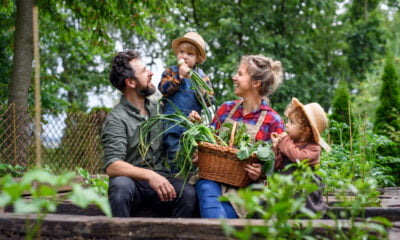

Lifestyle
6 Innovative Ways to Design a Sustainable Garden
Sustainability might not be at the forefront of our minds when it comes to designing our gardens, but it’s a factor that we can’t ignore any longer. With talk of global warming and some of the harshest weathers we’ve seen in a long time, creating a garden that is sustainable not only for us but for the environment too is a great way to make the most of our outdoor spaces.
But where to begin? Here are six design tips for a sustainable garden to get you started.
1. Choose the Right Furniture
When someone says the words “garden furniture,” we might think of a whole host of different images. For some, it’s the plastic tables and chairs that make for easy storage, and for others it’s ornate benches and hefty wooden tables and chairs. However, if you truly want a sustainable garden, teak garden furniture is likely to be your best bet. While it may not be the cheapest option on the market, teak is more often than not sustainably sourced and will stand the test of time in your garden. It’s resilient against mould, mildew and all kinds of weather, so it’d be an investment to last you a lifetime.
2. Mulching
For a garden free from weeds, mulching your flowerbeds is a good place to start. Using mulch prevents weeds from being able to grow and will also keep the soil beneath moist and healthy. During the summer months, this can be incredibly useful, especially if you live in a place where water conservation often kicks in as the weather gets warmer. A two- to three-inch layer of shredded bark, cocoa bean hulls, grass clippings, pine needles and other mulch materials around your flowerbeds will ensure optimal moisture underneath and potentially even higher-quality plants.
3. Grow Your Own Food
For something unique in your garden that’s not only sustainable, but useful too, why not try your hand at growing your own food? Of course, what you can grow will depend on how much maintenance the plants require, how much you can give, and what the overall climate will be throughout the year. Whatever the case, growing your own herbs, fruit and vegetables is not only useful — it’s satisfying too. There’s no better feeling than digging into your very own home-grown food and knowing exactly what work has gone into growing them from seed to table.
4. Reuse Your Resources
Reusing resources and repurposing household items is a great way to promote recycling within your own household. Whether you choose to use old cups as plant pots or use your cardboard toilet tolls as seedling-raisers, there is likely to be a use for everything somewhere in your garden. You can re-use plastic bottles to protect seedlings too or use old and broken DVDs and CDs to scare off birds looking to nab your seeds or growing plants.
5. Harvest Water
Collecting water to use in your garden is another great way of preventing excess water waste and is especially useful when on water rationing. For example, by having a bucket in your shower, you can collect any water that would otherwise be going down the drain (within reason) to use to water your plants. Similarly, having a rain tank or barrel in the garden – this can be as simple as a plastic bin! – can collect rainwater to use on your plants during dry spells of no rain.
6. Compost
Composting is probably one of the most recognizable and effective ways to maintain a sustainable garden. You’re not only enriching the soil, but you’re reducing the amount of waste you throw in the garbage. Using biodegradable waste like vegetable scraps and coffee grounds and spreading green manures helps to keep moisture in the water while adding nitrogen and other essential nutrients to whatever you aim to grow. Stronger soil also means less runoff erosion in the spring and fall. And during late fall, you can also compost by raking leaves into the garden area before winter’s first snowfall.
Keeping your garden looking amazing while remaining sustainable isn’t as difficult as it might initially seem. With a handful of reusable resources, some collected water and the right garden furniture to keep you comfortable, your garden can be your haven without costing you a fortune or being damaging to the environment.
Follow these tips to not only enjoy a beautiful garden and tasty homegrown food but to keep the Earth healthy and stable. Something as simple as sustainable gardening can make all the difference in the world as the climate changes – hopefully for the better.


 Environment10 months ago
Environment10 months agoAre Polymer Banknotes: an Eco-Friendly Trend or a Groundswell?

 Environment11 months ago
Environment11 months agoEco-Friendly Home Improvements: Top 7 Upgrades for 2025

 Features9 months ago
Features9 months agoEco-Friendly Cryptocurrencies: Sustainable Investment Choices

 Features10 months ago
Features10 months agoEco-Friendly Crypto Traders Must Find the Right Exchange





























